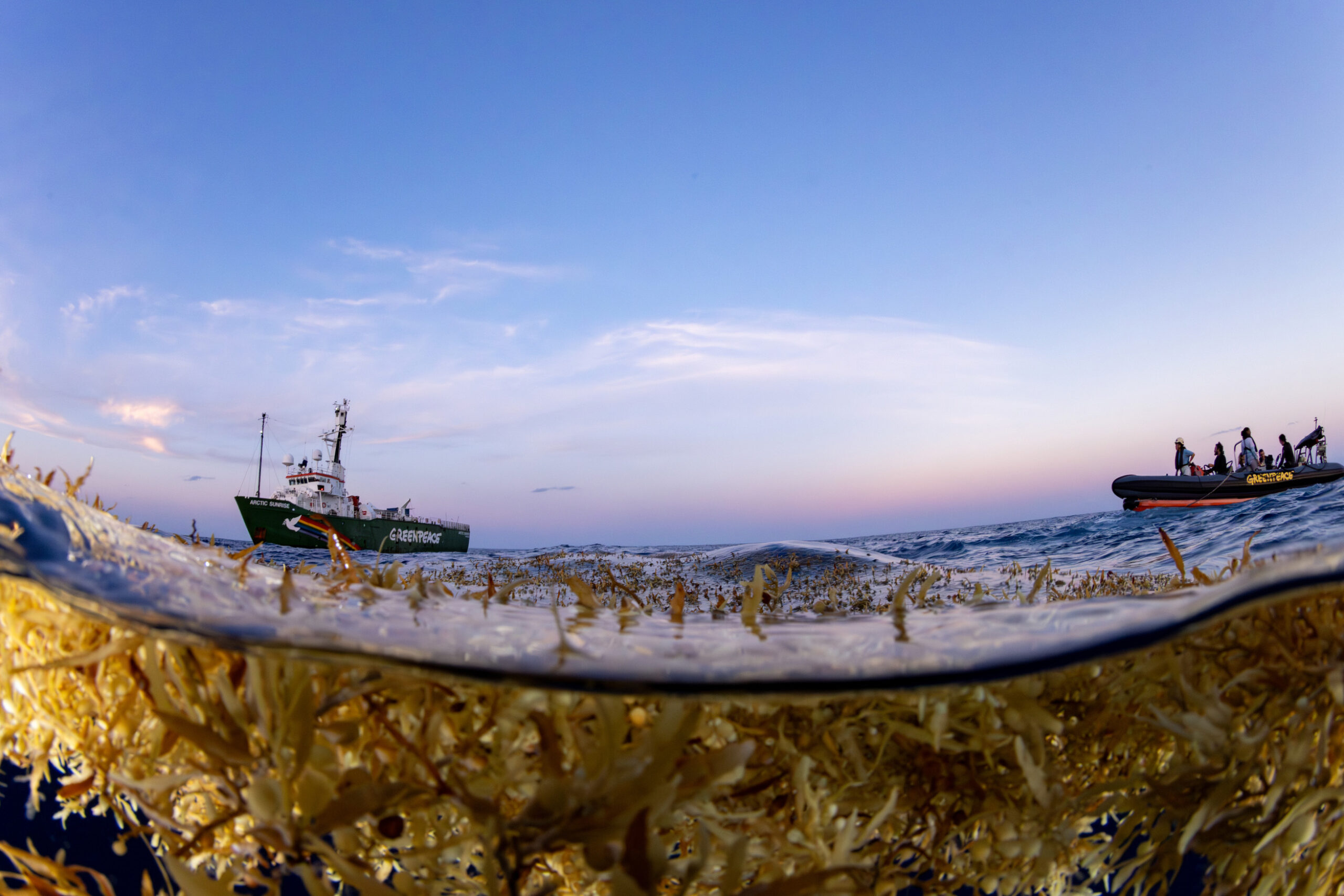
- Press Release
Sargasso Sea surveys find vulnerable sperm whales and elusive pygmy sperm whales, as Greenpeace calls for ocean sanctuary
London, 28 August 2025 – The presence of elusive pygmy sperm whales, as well as vulnerable and near-threatened species, has been detected in the Sargasso Sea using innovative environmental DNA sequencing and acoustic surveys, boosting calls for it to be declared an ocean sanctuary under the Global Ocean Treaty.
Greenpeace’s ship Arctic Sunrise spent three weeks on a voyage through the Sargasso Sea in May 2024, taking samples of seawater for ‘eDNA’ analysis[1] and carrying out an acoustic survey using hydrophones[2]. Greenpeace UK campaigners collected the samples, with help from British band Bastille’s frontman Dan Smith[3]. The scientific analysis of the samples was jointly funded by Greenpeace UK and the Sargasso Sea Commission, and used specialist equipment provided by the Greenpeace Research Laboratories based at the University of Exeter.
The eDNA analysis, carried out by researchers at the Universities of Edinburgh and Exeter, revealed the presence of approximately 40 vertebrate species across the area surveyed, representing a diverse range of roles in nature and steps in the food chain, from flying fish at the surface to deep-sea lanternfish. Five species of marine mammals were detected – the bottlenose dolphin, pantropical spotted dolphin, Gervais’ beaked whale, pygmy sperm whale and South American sea lion [4]. Modern bony fish from at least 14 families were recorded, such as flying fish, jacks and trevallies, as well as tunas, mackerels and eels. Some fish could be identified to species level, such as the Sargassum frogfish, yellowfin tuna and veiled anglemouth, while some could only be detected as far as their biological group. European eels famously migrate to the Sargasso Sea to spawn, on an epic journey all the way from freshwater rivers in the UK and elsewhere in Europe.
Groups such as tuna and flying fish play critical roles in oceanic food webs and also support commercial and subsistence fisheries throughout the Atlantic. The detection of species listed by the IUCN as Near Threatened (Atlantic salmon) or Data Deficient (Crevalle jack) highlights the importance of the region as a refuge for biodiversity and how vital it is for the Sargasso Sea to be properly protected.
Dr David Freestone, Executive Secretary of the Sargasso Sea Commission, said:
“Our thanks to Greenpeace for helping with the funding for this groundbreaking study. These exciting eDNA results will be a very useful addition to the Commission’s major 400-page Socio-Ecosystem study, which we will use as the basis for our strategic conservation action programme in 2026.”
A total of eight acoustic encounters were recorded during the survey[5]. Two detections were of sperm whale groups, the first with four individuals and the second with two whales. Deep-diving sperm whales are globally designated as Vulnerable on the IUCN Red List of Threatened Species. They are highly migratory, dependent on travelling through open areas like the Sargasso, so this detection is important in underlining the need for the Sargasso Sea to be protected as an ocean sanctuary. The remaining six acoustic detections were dolphin encounters.
Noelle Young, Sustainability Solutionist & Environmental Justice Delegate from Bermuda, said:
“Bermuda’s identity is deeply tied to the health of the Sargasso Sea, a unique Atlantic ecosystem that is defined not by land boundaries but by ocean currents. Its floating mats of Sargassum seaweed are a vital habitat for marine creatures found nowhere else such as the Sargassum frog fish, tiny pygmy sperm whales, shrimp, crabs, flying fish and more. It is a spawning ground for American and European eels and an important route for highly-migratory and vulnerable humpback whales and sea turtles. Sadly this valuable marine environment is threatened by environmental change, industrial fishing and pollution, but there is hope. The Sargasso is a prime candidate for protection under the High Seas Treaty. This protection would improve the lives of local communities as well as precious wildlife, because the Sargasso Sea is also vital to our climate and economy. Civil society in Bermuda – from fishers and local businesses to scientists – are pushing for its protection and governments like the UK must join us in championing the Sargasso Sea as one of the first ocean sanctuaries under the Treaty.”
Since most of the Sargasso Sea lies in the high seas, outside national borders, tools for restricting human activity there have been extremely limited in the past. The Treaty will make it possible for governments to create sanctuaries on the high seas – protected from all destructive activities – where marine life can recover and thrive. Greenpeace UK is calling on the UK government to propose the Sargasso Sea as one of the first ocean sanctuaries under the Global Ocean Treaty, as a part of a global network of protected areas.
Chris Thorne, senior oceans campaigner at Greenpeace UK, said:
“The samples and recordings taken from right across the Sargasso Sea show how rich in biodiversity its waters are. We saw from our ship that the Sargasso Sea is a wildlife haven and this thorough scientific analysis now proves the incredible range of species which inhabit and pass through the Sargasso Sea. We’re all thrilled to know that pygmy sperm whales are resident in the region as they are notoriously elusive and difficult to see.
“Sadly our research has also shown that the Sargasso Sea is facing growing pressure from shipping and industrial fishing fleets. Drifting longlines pose a major risk to this precious ecosystem because they fish indiscriminately, hooking marine mammals, turtles, seabirds and sharks along with their intended catch[6]. Huge container ships and tankers plough through these waters day in, day out. In order to give the life of the Sargasso a fighting chance, and support Bermudians who depend on it, the UK and other governments must champion the Sargasso Sea as one of the first ocean sanctuaries under the Treaty and work with the government of Bermuda to manage it.”
Bastille frontman Dan Smith, who travelled to the Sargasso Sea with Greenpeace UK on the Arctic Sunrise, and who helped take eDNA samples and deploy the hydrophone, said:
“Environmental DNA sampling is a little bit of magic. It can find out different sea creatures that have passed through these wide blue waters, from little snipe eels to pygmy sperm whales, just from their DNA. And to capture sounds of sperm whales and dolphins communicating on a hydrophone, to hear their clicks and whistles, is incredible. I loved helping out a bit with this Sargasso Sea science.
“I performed my song Blue Sky & the Painter amid the sapphire waters of the Sargasso Sea, which I found truly captivating. It’s a song of hope and resilience and I really think protecting our blue planet is possible with the help of the Global Ocean Treaty. This historic agreement was years in the making but it’s going to enter into force soon and then governments can get on with the exciting bit, making a massive network of ocean sanctuaries on the high seas – like national parks on the ocean. As Sir David Attenborough has told us, ocean ecosystems can bounce back, we just need to protect them so they can.”
Governments are meeting at the UN until 29th August, to continue talks about implementing the Global Ocean Treaty or High Seas Treaty. As it moves towards entering into force, with only eight more countries required to complete ratification before it commences, the next priority is how the Treaty can be used to create ocean sanctuaries covering 30% of the world’s oceans by 2030. Greenpeace UK is calling for the just and equitable protection of the ocean, and urging progress on priority sites in the Atlantic and across the globe, including the Sargasso Sea.
ENDS
High-res photos and video of the scientists and campaigners on the Arctic Sunrise in the Sargasso Sea can be accessed from the Greenpeace Media Library. Maps of the sample sites for both eDNA and acoustic data are also available.
Contact
Greenpeace UK Press Office, press.uk@greenpeace.org, 0207 865 8255 (including out of hours)
Editor’s notes
The methodology used by the scientists is available – eDNA analysis and acoustic survey.
1- Environmental DNA (or eDNA) refers to genetic material obtained from environmental samples, such as water, soil, or air, without the need for direct observation of the target organisms. This DNA originates from cellular material shed by organisms into their surroundings through processes like excretion, reproduction, skin sloughing or decomposition. Once collected, eDNA can be extracted through a variety of methods and analysed using molecular techniques such as quantitative PCR (qPCR) or high-throughput sequencing (HTS), enabling researchers to identify the presence of individual species or assess entire communities.
eDNA is widely considered to be groundbreaking in conservation biology. It allows scientists to detect organisms just from traces of DNA, in a non-invasive way. It can be used to look for fish, mammals and other types of marine life. It is highly sensitive, and therefore able to detect rare or elusive species at low abundances, which is valuable for biodiversity surveys. It can be faster and cheaper than other types of labour-intensive fieldwork, enabling large-scale monitoring, as well as providing additional lines of evidence alongside more routine visual and acoustic surveys.
2 – Acoustic data were collected from the Arctic Sunrise during hours of darkness using a hydrophone array comprising four hydrophone elements. The hydrophone array was towed behind the vessel with a 350 m cable. Two elements formed a medium frequency pair spaced 3 m apart, and two formed the high frequency pair spaced 50 cm apart. Each hydrophone element was connected to a four-channel data acquisition card where analogue gain and filtering were applied.
3 – Dan Smith was on board the Arctic Sunrise to learn more about the importance of ocean protection and to join campaigners in engaging with civil society, fishers and decision-makers in Bermuda and the wider region. The scientific analysis of the samples was jointly funded by Greenpeace UK and the Sargasso Sea Commission. Scientists from the University of Edinburgh, University of Exeter and Greenpeace Research Laboratories have worked together to examine the samples and data and to prepare the findings released today.
Dan Smith spent three busy days onboard the Arctic Sunrise taking part in the scientific research, assisting with the collection of eDNA samples and deploying the hydrophone. He also took part in a beach clean on Cooper’s Island in Bermuda. He recorded a live performance of a previously unreleased song called Blue Sky & The Painter from onboard the Arctic Sunrise in the middle of the Atlantic Ocean (now available on the & album). The video of the performance shows Dan sitting on the prow of the iconic Greenpeace ship playing an acoustic guitar as the sun sinks into the deep blue water of the ocean all around him. The video is available to watch on YouTube.
4 – Some species detected by the eDNA analysis, such as the South American sea lion, fall outside of known geographic ranges and therefore should be interpreted with caution. However, they may indicate the presence of close relatives or insufficient representation in current reference data for the region rather than an incorrect detection. Such findings reflect the need for local taxonomic validation alongside eDNA.
5 – Greenpeace UK campaigners and scientists from the University of Exeter and the Greenpeace Research Laboratories also carried out an acoustic survey in the Sargasso Sea, at a range of sites along the same transect that the eDNA samples were collected from.
6 – ‘Nearly 2,000km of fishing line dragged through Sargasso Sea last year as Greenpeace demands greater protection’ – our 2024 research is available on the Greenpeace UK website. In the Sargasso Sea alone in 2023, fishing vessels used drifting longlines with an estimated combined total length of 1,980 kilometres, enough to cover the distance from the UK to Morocco.
